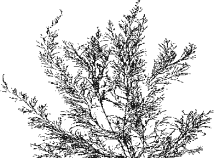 Synonyms:
Fucus barbatus Goodenough a. Woodward, 1797; Cystoseira
hoppii Agardh, 1821.
Synonyms:
Fucus barbatus Goodenough a. Woodward, 1797; Cystoseira
hoppii Agardh, 1821.Cystoseira barbata (Good. et Wood. Ag., 1821)
 Synonyms:
Fucus barbatus Goodenough a. Woodward, 1797; Cystoseira
hoppii Agardh, 1821.
Synonyms:
Fucus barbatus Goodenough a. Woodward, 1797; Cystoseira
hoppii Agardh, 1821.
Common names: Rom: Cistoseira.
Order (Scientific): FUCALES.
Family (Scientific): SARGASACEAE.
Taxonomic description: The thallus is 15-20 cm tall-each branch ends with a conic foot (sole); in most cases the basement branches are joined together in a common base. The stem is narrow enough, 3-5 mm thick, cylindrical, the final side is smooth and unequal. The main branches are alternatively or chaotically branched from the stem, very long, cylindrical shape, plenty of small branches whose number gradually decreases, leaving a few singular cylindrical small branches, much shorter than the initial ones; the small branches are uniformly distributed along the main branches or come together as brooms nearest their tops. In winter and spring there are many (air) bladders on branches. Cryptostoma are numerous on the surface of the branches and (air) bladders. The receptacles are spare-shaded or cylindrical 0.2-1 cm long, strongly stressed on the scaphidia surface and with phyliphorm sterile tops; gathered in dense instalments on the lateral surface of the branches: often in the receptacles the (air) bladders are metamorphozed and are distributed close the top branches .
 IUCN
Status:
IUCN
Status:
World level:
Black Sea Regional level:
Subregion level: EN
Distribution:
Habitats type, Critical habitats, Limiting factors: Rocky bottoms on pebbly grounds in sublittoral areas at 0.5-10 m depths. Present also in the Azov and Mediterranean Seas. Species belonging to inferior northern area. Suspended particles, diminution of light penetration.
Biology: Perennial; fond of light; the reproduction occurs at a depth of 0.5-5 m .
Population trends: Almost disappeared. On the Romanian littoral, in the southern zone Tuzla-Vama Vech, the biomass of Cystoseira has decreased from 5,400 t fresh weight in 1971 to 755 t in 1973 and 120 t in 1979. The first destructive came from the freezing of the sea water during the 1971/1972 winter when shifting floating ice destroyed about 80% of the stock of Cystoseira reaching 900 t in 1972. Currently, only isolated tufts.
Threats: Hard frosts, hydrotechnical construction, silting of the rocky bottom by suspended matter, lowering of light energy penetration through the water column by increased turbidity and eutrophication.
Conservation measures taken:
Conservation measures proposed: Reduce eutrophication and pollution from point and non-point sources; declaration and protection of the southern sector of the Romanian littoral (2 Mai-Vama Veche) as a natural submarine park.
References:
Compiled by: A.Bologa, A.Bavaru.